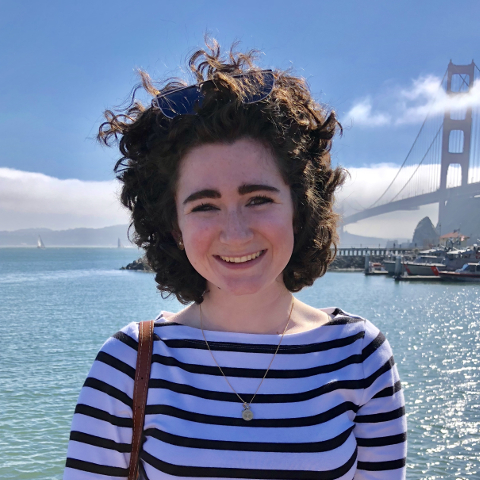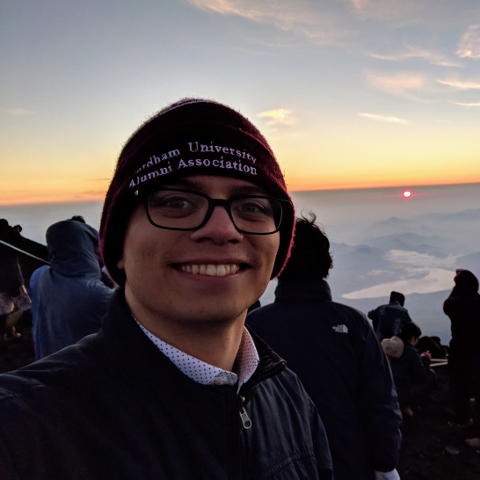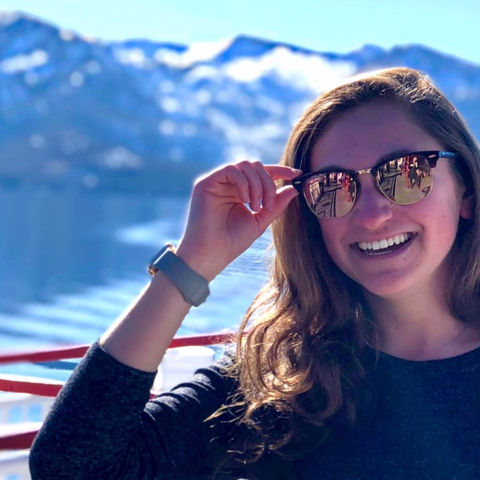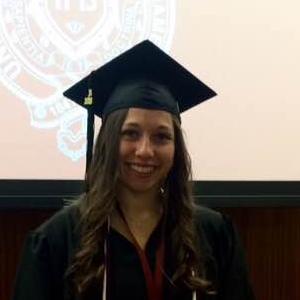Physics and Engineering Physics Alumni
Wondering what former Fordham physics and engineering physics students are doing after they graduate? Below we will spotlight our graduates and their various career/school paths after leaving Rose Hill!
If you are interested in being added to our list below, please email Christopher Aubin with your information (specific degree, graduation year, and anything you wish to share with us). Also, many of our alumni have been happy to share their contact info if you wish to get in touch with them about their experiences, so click on their names to get in touch!
Alessandro Baccarini (FCRH 2017, Physics)
I am currently pursuing my Masters in Cybersecurity through Fordham's GSAS. I have published in several journals and conferences pertaining to cryptography on low-resource devices, novel blockchain applications, and biometric machine learning fusion. Additionally, I teach Physics I and II lab in the department. My goal is to pursue a Ph.D. in Computer Science.
Jason Bini (FCRH 2006, Physics)
My interests, and the overall trajectory of my career, have focused on the application of physics and engineering principles to increase knowledge of both normal physiology and diseases to improve medical care. Upon completion of my Bachelor’s in Physics (FCRH ’06), I was employed as a research assistant at Memorial Sloan Kettering Cancer Center and enrolled in a Master’s degree program in Biomedical Engineering at Stevens Institute of Technology. Establishing collaborations between both institutions, my research explored the use of optical imaging techniques to guide surgeons assessing tumor margins during skin cancer surgery. For my doctoral studies, at The City College of New York (CUNY) and the Icahn School of Medicine at Mount Sinai, my research was focused on using innovative techniques with positron emission tomography and magnetic resonance imaging in cardiovascular disease.
My postdoctoral studies took me to Yale University where I joined the Departments of Biomedical Engineering and Radiology and applied positron emission tomography techniques to understand and potentially guide diabetes treatment. Currently, as an Associate Research Scientist in the Department of Radiology at Yale, my research applies physics and engineering techniques in multiple imaging modalities to explore both neurological and whole-body pathophysiology in obesity and diabetes. A degree in physics provided an excellent foundation for understanding principles of medical imaging and establishing a research career in physics, engineering and medicine.
Connor Bruce (FCRH 2018, Engineering Physics)
I am currently working at AKF Group LLC as an electrical engineer.
Christina Caravello (FCRH 2018, Engineering Physics)
I am currently working for Con Edison’s Gas Engineering Department as an Engineering Analyst. In the Gas Engineering and Systems Reliability department, I work closely with other departments such as Pressure Control and Leak Survey to support the engineering team’s designers as they map out current and future projects for main replacement, installation and repair in Queens, Manhattan, Westchester, and the Bronx. My future goals are to earn a Masters degree in mechanical engineering as well as to become a licensed PE in the state of New York.
Maddie Carsello (FCRH 2019, Physics)
I graduated with my BS in Physics and a minor in Mathematics spring of 2019. The following summer I accepted a job to teach 11th grade physics at Uncommon Charter High School in Brooklyn. While teaching, I will also be simultaneously pursuing a Master of Arts in Teaching from the Relay Graduate School of Education. Contact me at the above link if you have any questions.
Charlie Carver (FCRH 2018, Physics)
I graduated from Fordham in 2018 with a degree in Physics and minor in Mathematics. I am currently a Computer Science Ph.D. student at Dartmouth College where I research visible light communication and sensing within the DartNets Lab. I was recently awarded the 2019 NSF Graduate Research Fellowship, providing additional funding for my laser research over the course of my graduate studies.
Brian Caulfield (FCRH 2016, Engineering Physics)
Brian Caulfield. BCFresh. BRIDoggy69. BRIrannosaurus Rex. The list goes on and on. No matter the name he remains the same. After graduating from Fordham University, he took his talents into the United States Air Force to work as a Space Operations Officer. However, he was unaware how outstandingly dull he would find the job. Now he sits at a computer all day as Lieutenant Caulfield, dreaming of the day he can separate from the Air Force. Right now, his goal is to return to the college life to study for a PhD and then move on to become a professor, though in his heart he knows life changes and he may find himself walking down a totally different path. Stay tuned to see where this Fordham grad finds himself next.
Katrina Colletti (FCRH 2014, Physics)
After graduating from Fordham, I moved to College Station, Texas to start graduate school in Physics at Texas A&M. While there, I focused on high energy experimental research; in particular I was part of the Super CDMS (Cryogenic Dark Matter Search) collaboration. I mainly worked with the Detector Monte Carlo group which aims to simulate through code the detector response from a particle coming in and interacting with the detector. I also did some phenomenology research with my advisor that led to a publication. I graduated with my Master's degree, and stayed in College Station for a year teaching physics and algebra to 6th graders and high schoolers.
After moving back to New York, I worked at the National Museum of Math before realizing I wanted to change gears a bit and work with animals. I worked at the ASPCA for a bit taking care of the shelter animals, and currently I am working as a Veterinary Assistant at a local Animal Hospital. I absolutely love working with animals now (though I also still love meeting up with my physics major friends whom I graduated with and talking about science), and plan to eventually go back to school for a Vet Tech program or Veterinary school.
Adam D'Agostino (FCRH 2018, Engineering Physics)
I graduated in 2018 with a BS in Engineering Physics and a minor in Mathematics. After graduating, I immediately began working as a tech support specialist for an audio equipment retail company. Pursuing my passion for music and audio engineering, I was promoted to Project Manager shortly after. I am now responsible for a range of different tasks including product testing, quality control management, and even data entry - dealing a bit with E-Commerce and marketplace platform integration. The title of my position essentially implies that I work directly under my boss - I do any sort of tasks he throws at me, which is a great starting point for my professional career. Oftentimes, I have considered graduate school, but I am not yet fully convinced that it's for me. In my off-time, I pursue my own personal musical endeavors, writing music and producing/mixing for other talented artists. My initial concern as a senior was that I would not find a career path that would balance my interests in engineering with my passion for music. So far, I believe that I am off to a good start
Sanja Dmitrovic (FCRH 2018, Engineering Physics)
I am currently pursuing my Masters in Optical Sciences at the University of Arizona. My concentration is photonics and quantum optics. I am currently researching ultra-sensitive nanoparticle detection for chemical threat detection. Specifically, my role is to minituarize our current system so it can fit in drones. Throughout my career, my goal is to research how to transition to photonics-based devices to overcome the limitations of our current electronics-based technology.
Colin Dobell (FCRH 2015, Engineering Physics)
I am a law student at University of Pennsylvania, currently on leave for a semester and am working with an organization that does climate change related impact litigation.
Pedro Espino (FCRH 2012, Physics)
I'm currently a PhD candidate at the University of Arizona getting close to graduation. My research focuses on Neutron Stars within numerical relativity, where we solve Einstein's equations on a computer. Upon receiving my PhD I will apply for both postdoctoral research positions and data scientist positions in private industry. I also work with the U of A Physics REU, which accepts out of state students. I’m happy to offer advice to anyone who is interested in applying to the U of A or grad school in general, or would be interested in our REU!
Tony Fox (FCRH 2018, Engineering Physics)
I am currently a mechanical engineer for Hubbell Electric Heaters Co. in Stratford, CT. We specialize in electric heating for many applications—water, alcohol, glycol, oil and other liquids. I focus on steam generation systems for commercial and governmental use, indirect water heating systems from heat exchangers, and custom water heater systems for the Navy.
I also am a teacher for two nonprofits--Upward Bound and Bridgeport Organization for Youth Sports (BOYS). For Upward Bound, I teach a coding module that explores user experience (UX) design and building apps for grades 9 - 12. For BOYS, I teach a project based STEM program through Lego robotics for 4th to 8th graders. I structure this program as if it were an engineering firm with: a project engineer, quality engineer, material engineer, mechanical assemblers… etc. The students love to embrace these roles and learn to become an active owner of their contribution to each project. I never thought that I would love teaching.
Lastly, I have been elected to sit on the Board of Education for the Diocese of Bridgeport. I help oversee the four Catholic Schools in Bridgeport, CT and raise $2M. Currently, I sit on the Marketing Committee and helped launch a grassroots initiative to partner with local churches. It is our goal to earn the right and convince parishioners to give our schools a chance and apply.
Aside from work, I enjoy working out, developing apps and business ideas, and traveling. One thing I value about engineering is that it taught me the foundations of problem solving. This allows me to apply this concept into many facets of my life. I was able to make it through Aubin's Thermostats course, so I can do (almost) anything!
If there are any curious young engineers or physics students that want the 411 of what life is like after graduation or in the young professional working world, please contact me at the email linked above or on LinkedIn!
Nick Geiser (FCRH 2017, Physics)
I am now a physics PhD student at the University of California, Los Angeles. In 2018 I received an MS in physics from UCLA. My research interests include string theory, quantum gravity, and more broadly, symmetries in physical theories. My undergraduate senior research project with Dr. Christopher Aubin well-prepared me for theoretical physics work at UCLA. My studies at UCLA are supported by a Eugene V. Cota-Robles Fellowship and a Graduate Dean's Scholar Award.In my free time, I organize for the University of California graduate student workers union, UAW 2865, to ensure graduate students are fairly compensated and protected in their workplace.
Chris Guerrero (FCRH 2015, Engineering Physics)
I'm a motion controls engineer at NSLS-II, the "National Synchrotron Light Source II," at Brookhaven National Lab out on Long Island. Anyone can contact me and my email (linked above) or even by phone if you're interested in learning more: 631-344-8729. More information on what I do can be found by clicking here.

Bernadette Haig (FCRH 2018, Engineering Physics)
The summer after graduation, I interned at NASA Glenn Research Center in Cleveland, OH. My project used CFD (computational fluid dynamics) to study how air masses move over and through cities, with the goal of understanding the propagation of urban weather patterns on a small scale. NASA plans to use this work to help develop safety standards for UAVs (unmanned aerial vehicles) and air taxis in cities.
This past fall, I started a Master's program in Aeronautics and Astronautics at Stanford University. I'm leaning towards a career in propulsion engineering, so I'll likely declare a concentration in fluids.
This coming summer (2019), I'll be interning with Northrop Grumman in Promontory, UT (Salt Lake City area). I'll be doing CFD again, this time with a group of analysts that study the physics of solid-fuel rocket motors, among other things.
Gzim Hasandjekic (FCRH 2018, Engineering Physics)
I'm currently working for a developer as the head of their carpentry division. I have about 10 workers that I manage and we are currently building 8 buildings in The Bronx. I am also during my Master's at Fordham University for Real Estate Finance. I am a full time employee and a full time student. Anyone can email me (link above), if anyone has any questions.
Maeve McGowan (FCRH 2018, Engineering Physics)
After graduating from Fordham in 2018 with a BS in Engineering Physics and a concentration in Biomedical Engineering, I took a position as an Enrollment Operations Specialist in the Graduate Division of Pace University, where I was also able to take a few courses in preparation for graduate school. I am currently preparing to pursue a Master's in Biomedical Engineering; as my interests lie in the nexus between medicine and technology development, I hope to continue from there into the field of prosthetics. My current plan is to work in the design sector of the prosthetics field, but I am also interested in prosthetics that incorporate brain-machine interfaces, and I remain open-minded about other interests I may find while completing my degree.
In my position at Pace University right now, I have gotten to learn a lot about the flip side of applying to graduate school, which was definitely interesting and helpful. Most importantly, I got to see the "do's" and "don'ts" when applying, like what makes applicants stand out positively and what actions essentially get you blacklisted by the counselors. If you would like to contact me for questions about that, please feel free to do so!

John Murray (FCRH 2016, Engineering Physics)
I work with Harris Corporation as a systems engineer on the Global Positioning System program. Formerly managing requirements for signal generation hardware aboard the GPS III satellites, I now test software for the next-generation ground control station. I am currently enrolled as a part-time distance learning student at the University of Alabama, pursuing an M.S. in Aerospace Engineering and Mechanics. (You can also find me on LinkedIn.)

Elizabeth Orsini (FCRH 2016, Engineering Physics)
Currently, I work as a Sr. Software Engineer at Optum Technology in Boston, MA. I joined Optum through the Technology Development Program, which consists of two six-month rotations where candidates are able to experience different parts of the business. In my current role, I oversee teams of software engineers with the goal of delivering high quality applications at a reduced speed. I’d be happy to discuss opportunities in the health care industry and software engineering in general!
Drew Rotunno (FCRH 2014, Physics)
I graduated from Fordham with a major in Physics, and minors in Mathematics and Philosophy. I was a member of Fordham Experimental Theatre, as well as the improv and stand-up groups. I learned about lasers, optics, data acquisition and coding during summer research in Stephen Holler’s lab. I went on to the College of William & Mary for my masters and graduate work, receiving my Ph.D. in 2021 under Seth Aubin. My research there was on trapping and manipulating cold atoms using MHz-range magnetic field gradients and the AC Zeeman effect. This work created a novel cold atom trap which can target individual spin states. After graduating, I moved on to the National Institute of Standards and Technology (NIST) in Boulder, CO, in the Electromagnetic Fields Group of the Communication Technology Laboratory. We develop the use of Rydberg atoms as “self-calibrated” electric field sensors and broadband radio receivers. Projects in this group include improving sensitivity, bandwidth, dynamic and frequency ranges for Rydberg sensors, supporting industry in manufacture of atomic sensors, as well as more exotic projects such as an atomic radiation thermometer.
Matt Roveto (FCRH 2016, Physics)
Currently, I am employed as Math and Computer Science teacher at St. Anthony's High School in South Huntington, Long Island while pursing my MS in Electrical Engineering full-time at NYU Tandon School of Engineering. Currently my research interests are focused around modeling Peer-to-Peer (P2P) interactions in the Distribution Electricity Market, More generally, I am interested in problems pertaining to stochastic programming from a system operational perspective, especially as they apply to the power grid.
Eve Stenson (FCRH 2004, Physics)
After graduating from Fordham, I went to Caltech for grad school. I originally started in Materials Science but after a year or so transitioned to the Applied Physics department when I got into plasma physics. My Ph.D. thesis was about equilibria and dynamics of "loops" of plasma (arched, plasma-filled magnetic flux tubes, which can both be found in the solar atmosphere and created in the laboratory).
After that, I came to Germany to postdoc, where I've been working in the APEX (A Positron-Electron eXperiment) collaboration --- first at the Max Planck Institute for Plasma Physics and now at the Heinz Maier-Leibnitz Research Neutron Source (FRM II), which is part of the Technical University of Munich. Research-wise, I get to play with "antimatter containment devices", as we progress toward our goal of confining electron-positron plasmas in the laboratory (so that we can then test some of the many predictions about how "pair plasmas" differ from standard, electron-ion plasmas). Starting in a little under a year, I will be launching a "Helmholtz Young Investigator Group" to build a tabletop-sized optimized stellarator for that purpose, to complement the levitated dipole trap that is already under development.
Raymond Tomlan (FCRH 2016, Engineering Physics)
After Fordham, I moved to LA to pursue my Masters of Science in Civil Engineering - Structural Engineering at the University of Southern California. While there, I met DCI Engineers at the career fair, which is a structural design consulting firm with 13 offices up and down the Western half of the United States specializing in mid-rise to high-rise construction. I began interning there in May of 2017, joining full time in August of 2017 while finishing my degree. I graduated from USC in December of 2017, and have been working for DCI and working towards receiving my Professional Civil Engineering License (PE).

Marissa Vaccarelli (FCRH 2018, Engineering Physics)
After graduating from Fordham, I enrolled the Medical Physics Program at Hofstra University, where I received my M.S. in May, 2020. During my time in graduate school, in addition to coursework and clinical practical, I worked on a research project developing automated treatment planning software used to compute dose on CT’s of radiation therapy patients at Northwell Health’s Center for Advanced Medicine. I also served as an instructor of introductory physics lecture and lab to undergraduate students at Hofstra. I spent my summers at Memorial Sloan Kettering Cancer Center, assisting in a pilot study that aimed to model organ deformation for designing adaptive radiation therapy treatment plans.My ultimate goal is to become a board-certified medical physicist by the American Board of Radiology. Behind the scenes, every patient undergoing radiation therapy has a physicist who is responsible for the safe and effective delivery of ionizing radiation for medical proposes. Medical physicists have a wide range of activities involving clinical, research and teaching duties. In the clinic, the physicist is authorized to establish and maintain the quality assurance of high energy medical linear accelerators, as well as treatment planning and verification for external beam and brachytherapy applications.
Currently, I am Radiation Physics Resident at M.D. Anderson Cancer Center in Houston, TX to begin my clinical training. I hope to become an integral member of a patient’s radiation therapy team using physics for the greater good of fighting cancer. I am so grateful for all of the wonderful professors in Fordham’s Physics and Engineering Physics Department and would be happy to speak with prospective or current students!
Ryan Wichtowski (FCRH 2015, Engineering Physics)
I graduated from Fordham in 2015 with a bachelor's degree in Engineering Physics and a minor in Mathematics. After graduating Fordham, I attended Duke Law School and graduated in 2018 with a juris doctor degree. I am a member of the New York Bar and the United States Patent Bar, and am currently working in New York at the law firm Cravath, Swaine and Moore LLP. My law practice focuses on intellectual property transactions. Please feel free to email me with any questions about Fordham, Duke, law school or New York big law.
Dan Wines (FCRH 2017, Physics)
I am currently a PhD student at the University of Maryland Baltimore County (UMBC). I am a research assistant in the Simulation, Theory and Engineering of Advanced Materials (STEAM) lab at UMBC under Dr. Can Ataca. Our group’s research focuses on the theoretical investigation of materials, specifically 2D materials, for next generation devices. We employ quantum mechanical methodologies such as Density Functional Theory (DFT) and Quantum Monte Carlo (QMC) to investigate the electronic, optical, magnetic and transport properties of these correlated materials.